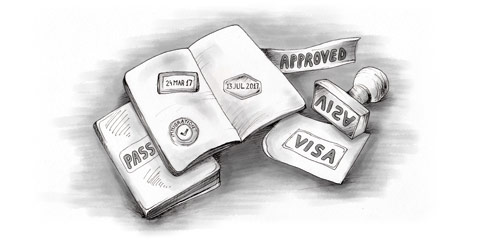Concerns have been voiced in Australia over jobs being taken from Australians by working holidaymakers; however, the farming industry, particularly fruit and vegetable picking, relies to a large extent on working holidaymakers to harvest crops. In 1997, a parliamentary committee decided that visitors on working holiday visas do take jobs from young Australians, despite evidence to the contrary showing that they take jobs where Australians either lack the necessary skills, are unwilling to take jobs or local labour isn’t available. But statistics also show that those on working holiday visas inject around $1.3 billion a year (2004/05) into the economy and many businesses in the tourist industry would be hard hit without them (creating unemployment). There’s no cap on the number of working holiday visas issued.
Eligibility
Working holiday visas are available to single people and childless couples between the ages of 18 and 30. The purpose of the working holiday visa is to allow young people the opportunity to visit Australia and supplement their travels through casual employment. Those eligible for a working holiday visa include (spring 2005) nationals of Canada, Denmark, Estonia, Germany, Ireland, Italy, Japan, Malta, the Netherlands, Norway, South Korea, Sweden and the UK. If you hold a British, Canadian, Dutch or Irish passport you may apply in any country; others must apply in the country of their nationality. Applicants must satisfy the following criteria:
- The prime purpose of the visit is a temporary stay in Australia and permanent residence isn’t intended.
- Employment is incidental to the holiday and is to be used to supplement the money that you bring with you.
- Employment hasn’t been arranged in advance except on a private basis and on your own initiative.
- There’s a reasonable prospect of your obtaining temporary employment to supplement your funds.
- You can show that you have reasonable funds to support yourself for some of your time in Australia and pay for your return air fare. The minimum amount required is around £2,000 in the UK, although it isn’t necessary to have a return ticket at the time of your entry into Australia. It helps to have relatives or friends in Australia who can provide extra funds if necessary.
- You meet normal character requirements and health standards, where necessary.
- Full-time employment isn’t taken for more than three months with one employer.
- You don’t remain in Australia longer than 12 months and leave Australia when your working holiday visa has expired.
- You don’t remain in Australia longer than 12 months.
- You sign a declaration not to undertake any studies in Australia apart from an English language course of a maximum of ten weeks.
From November 2005, individuals who do three months of harvest work in Australia will be able to apply for a second working holiday visa. People from all countries with which Australia has a working holiday agreement will be eligible.
Applications can be made in person or by post (preferred). You should apply for a working holiday visa at least four to five weeks before your intended departure date, and, if you’re applying by post you should send documents by recorded delivery. If your application is approved, your visa is valid for 12 months from the date of first entry to Australia. If your first arrival date in Australia won’t allow you to have your full 12 months there, you can apply for an extension, although there’s a fee. If you plan to apply for an extension, you should apply around two months before the expiry of your temporary entry permit. An extension of stay beyond 12 months after your first entry isn’t possible.

